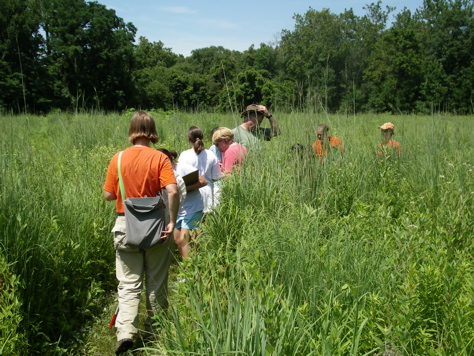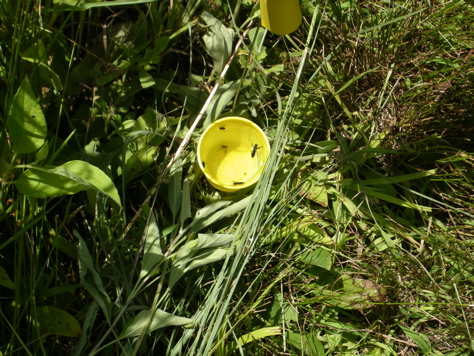In the a.m. of the day of the research project, Malinda set up two transects—one in the prairie and one in the woods. (A transect is a straight line used for sampling, such as to count the occurrence of a species in order to estimate its population size.) Along each transect she placed a plastic cup, or “bee bowl,” every 5 meters. The cups alternated in color (white, blue, yellow) and were filled with soapy water. The idea is that the bees are attracted to the color and can’t help themselves from flying into the soapy water.
Here we are hiking out to retrieve the bee bowls from the prairie.

This is a bee bowl.

Each student had a job. Here a student is pouring the contents of the bee bowl through a filter.


A different student had the job of spooning all the bugs from the filter.

The captured bugs were placed in specimen bags that were carefully labeled with the transect name (PRAIRIE or WOODS). A piece of paper inside the bag recorded other information, such as the date and the color of the cup.

Getting all the bugs off the filter proved challenging.

After transferring all the critters to the specimen bag, we hiked back to the deck to wash the specimens. This photo shows the set-up for the washing station.

The bees were shaken in jars with soapy water then rinsed with water. Next the bees were shaken in the jars with denatured alcohol, which helped to dry the bees. Here a student rinses the specimens.

The next step was to dry the bees. The students did so by spinning the bees in salad spinners. Why? To give lift to the bees’ hairs. If the hairs are matted, the bees are even more difficult to identify.

Here the students sort the bugs to separate out the bees.



The next step was to observe the bees (and other arthropods) and make detailed drawings.


Finally, students created permanent labels and pinned the bees to add them to Malinda’s collection. Eventually, Malinda will use technical manuals called dichotomous keys to identify the bees.

TA-DAH!!
